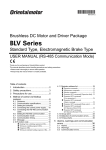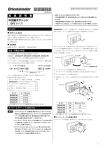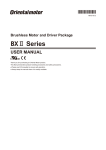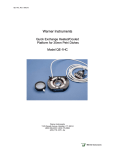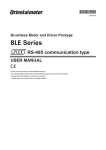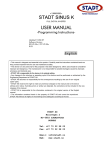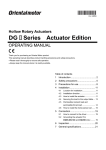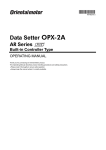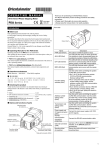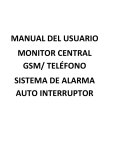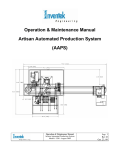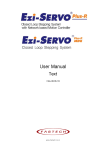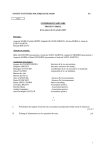Download BLV Series - Oriental Motor
Transcript
HM-5112 OPERATING MANUAL Brushless DC Motor and Driver Package BLV Series • Assign qualified personnel the task of installing, wiring, Introduction Before using the motor Only qualified personnel should work with the product. Use the product correctly after thoroughly reading the "Safety precautions". The product described in this manual has been designed and manufactured for use in general industrial machinery, and must not be used for any other purpose. Oriental Motor Co., Ltd. is not responsible for any damage caused through failure to observe this warning. Operating manuals for the BLV Series Operating manuals for the BLV Series are listed below. Read the manuals carefully before using your BLV Series unit. • BLV Series OPERATING MANUAL (This document) This manual explains the motor and driver functions as well as installation method, and others. • BLV Series USER MANUAL Basic function This manual explains the motor and driver functions, how to install/connect and troubleshooting, among others. Also, it explains operations using an accessory data setter OPX-2A. • BLV Series USER MANUAL RS-485 Communication Mode This manual explains how to control the motor via RS-485 communication using a programmable controller. CE Marking This product has been certified under the CE Marking requirements (EMC Directive) based on the EN Standard. Because the input power supply voltage of this product is 24 VDC/48 VDC, it is not subject to the Low Voltage Directive. However, install and connect this product as follows. • Installation conditions Motor and driver are to be used as a component within other equipment. Overvoltage category: I Pollution degree: 2 • EMC Directive Refer to USER MANUAL Basic Function for installation method. Hazardous substances RoHS (Directive 2002/95/EC 27Jan.2003) compliant Safety precautions The precautions described below are intended to prevent danger or injury to the user and other personnel through safe, correct use of the product. Use the product only after carefully reading and fully understanding these instructions. Handling the product without observing the Warning instructions that accompany a "Warning" symbol Caution Note Thank you for purchasing an Oriental Motor product. This Operating Manual describes product handling procedures and safety precautions. • Please read it thoroughly to ensure safe operation. • Always keep the manual where it is readily available. may result in serious injury or death. Handling the product without observing the instructions that accompany a "Caution" symbol may result in injury or property damage. The items under this heading contain important handling instructions that the user should observe to ensure safe use of the product. Warning General • Do not use the product in explosive or corrosive environments, in the presence of flammable gases, locations subjected to splashing water, or near combustibles. Failure to do so may result in fire, electric shock or injury. operating/controlling, inspecting and troubleshooting the product. Failure to do so may result in fire, electric shock, injury or damage to equipment. • Do no use any standard type in a vertical application. If the driver protection function is activated, the motor will stop and the moving part of the equipment will drop, thereby causing injury or equipment damage. • Do not use the brake mechanism of the motor with electromagnetic brake as a safety brake. It is intended to hold the movable parts and motor position. This caution is to avoid personal injury or damage to the equipment. • When the driver's protection function is triggered, first remove the cause and then clear the protection function. Continuing the operation without removing the cause of the problem may cause malfunction of the motor and driver, leading to injury or damage to equipment. Installation • Install the motor (gearhead) and driver in the enclosure in order to prevent injury. Connection • Keep the driver's input-power voltage within the specified range to avoid fire. • For the power supply, use a DC power supply with reinforced insulation on its primary and secondary sides. Failure to do so may cause electric shock. • Connect the cables securely according to the wiring diagram in order to prevent fire. • Do not forcibly bend, pull or pinch the cable. Doing so may cause fire. • Do not machine or modify the motor cable or extension cable. Doing so may result in fire. • Be sure to observe the specified cable sizes. Use of unspecified cable sizes may result in fire. • Observe the specified screw tightening torque when connecting terminals to the connector. Failure to do so may result in fire or equipment damage. Operation • Use a specified motor (gearhead) and driver combination. Failure to do so may result in fire or equipment damage. Maintenance/inspection • Always turn off the power before performing maintenance/inspection. Failure to do so may result in injury. • Regularly check the openings in the driver for accumulated dust. Accumulated dust may cause fire. Repair, disassembly and modification • Do not disassemble or modify the motor (gearhead) and driver. This may cause electric shock or injury. Refer all such internal inspections and repairs to the branch or sales office from which you purchased the product. Caution General • Do not use the motor (gearhead) and driver beyond its specifications, or injury or damage to equipment may result. • Keep your fingers and objects out of the openings in the driver, or fire or injury may result. • Do not touch the motor (gearhead) and driver during operation or immediately after stopping. The surface is hot and may cause a skin burn(s). Installation • To prevent the risk of damage to equipment, leave nothing around the motor and driver that would obstruct ventilation. • Do not hold the motor (gearhead) output shaft or cable. This may cause injury. 1 • Do not touch the motor output shaft (key groove or pinion) with bare • • • • • hands. Doing so may result in injury. When assembling the motor with the gearhead, exercise caution not to pinch your fingers or other parts of your body between the motor and gearhead. Injury may result. Securely affix the motor (gearhead) and driver to their respective mounting plates. Inappropriate installation may cause the motor/driver to detach and fall, resulting in injury or equipment damage. Provide a cover over the rotating parts (output shaft) of the motor (gearhead) to prevent injury. When installing the motor (gearhead) in the equipment, exercise caution not to pinch your fingers or other parts of your body between the equipment and motor or gearhead. Injury may result. Securely install the load on the motor (gearhead) output shaft. Inappropriate installation may result in injury. Operation • Do not shut off the negative side of the power supply during operation. Also, note that the wiring for the power supply does not disconnect. Doing so may cause damage to equipment. • Provide an emergency stop device or emergency stop circuit external to the equipment so that the entire equipment will operate safely in the event of a system failure or malfunction. Failure to do so may result in injury. • Immediately when trouble has occurred, stop running and turn off the driver power. Failure to do so may result in fire, electrical shock or injury. • Do not touch the rotating part (output shaft) during operation. This may cause injury. • The motor surface temperature may exceed 70 °C even under normal operating conditions. If the operator is allowed to approach the running motor, attach a warning Warning label as shown below in a conspicuous position. Failure to label do so may result in skin burn(s). Disposal • To dispose of the motor (gearhead) and driver, disassemble it into parts and components as much as possible and dispose of individual parts/components as industrial waste. Precautions for use • Regeneration energy When using the motor in operation such as vertical drive (gravitational operation) or sudden starting/stopping of a inertial load, regeneration energy may generate. Since the driver has no function to consume regeneration energy, if the output capacity or overvoltage allowance of the DC power supply is small, the protective function for the power supply or driver may activate and the motor may stop. When performing these operations, use a DC power supply or battery that has a large output capacity or overvoltage allowance. Also, use an electromagnetic brake motor not to drop the moving part in vertical drive (gravitational operation). If protective function for the power supply or driver is activated, contact your nearest Oriental Motor sales office. • Do not use a solid-state relay (SSR) to turn on/off the power A circuit that turns on/off the power via a solid-state relay (SSR) may damage the motor and driver. • Grease measures On rare occasions, a small amount of grease may ooze out from the gearhead. If there is concern over possible environmental damage resulting from the leakage of grease, check for grease stains during regular inspections. Alternatively, install an oil pan or other device to prevent leakage from causing further damage. Oil leakage may lead to problems in the customer’s equipment or products. • Apply grease to the output shaft of a hollow shaft flat gearhead If you are using a hollow shaft flat gearhead, apply grease (molybdenum disulfide grease, etc.) on the surface of the load shaft and inner walls of the hollow output shaft to prevent seizure. • Preventing electrical noise Refer to USER MANUAL Basic Function for measures with regard to noise. • Conduct the insulation resistance measurement or withstand voltage test separately on the motor and the driver. Conducting the insulation resistance measurement or withstand voltage test with the motor and driver connected may result in injury or damage to equipment. 2 • Note on connecting a power supply whose positive terminal is grounded The driver's main power supply input terminal (CN1), I/O signal connector (CN3), communication connector (CN5/CN6/CN7) and control power supply input terminal (TB1) are not electrically insulated. When grounding the positive terminal of the power supply, do not connect any equipment (PC, etc.) whose negative terminal is grounded. Doing so may cause the driver and these equipment to short, damaging both. • The driver uses semiconductor elements. Handle the driver with care. The driver uses parts that are sensitive to electrostatic charge. Before touching the driver, turn off the power to prevent electrostatic charge from generating. If an electrostatic charge is impressed on the driver, the driver may be damaged. • Use an extension cable (supplied) when extending the wiring distance between the motor and driver Preparation Checking the product Verify that the items listed below are included. Report any missing or damaged items to the branch or sales office from which you purchased the product. • • • • • Motor (with a gearhead, only for combination type) ..........1 unit Driver.....................................................................................1 unit Extension cable......................................................................1 pc. CN1 connector .....................................................................1 pc. OPERATING MANUAL (this document) ...........................1 copy Accessories for combination type • Hexagonal socket head screw set ........................................................ 1 set • Parallel key ........................................................................................ 1 pc. (Secured to the gearhead output shaft on the parallel shaft gearhead) • Safety cover ....................................................................................... 1 pc. (Supplied with the hollow shaft flat gearhead) • Safety cover mounting screw .............................................................. 2 pcs. (Supplied with the hollow shaft flat gearhead) Combinations of motors and drivers Verify the model number of the purchased unit against the number shown on the package label. Check the model number of the motor and driver against the number shown on the nameplate. • in the model names indicates a number representing the gear ratio. • indicates a number representing the length of an extension cable. • The combination types come with the motor and gearhead pre-assembled. • Standard type • Combination type parallel shaft gearhead Unit model Motor model BLV620K SBLV640N S- BLVM620K-GFS BLVM640N-GFS Gearhead model GFS6G Driver model BLVD20KM BLVD40NM • Combination type hollow shaft flat gearhead Gearhead model Unit model Motor model BLV620K FBLV640N F- BLVM620K-GFS BLVM640N-GFS GFS6G FR Motor model BLVM620K-A BLVM640N-A Driver model BLVD20KM BLVD40NM • Round shaft type Unit model BLV620KABLV640NA- Driver model BLVD20KM BLVD40NM • Name Electromagnetic brake type • Combination type parallel shaft gearhead Unit model BLV620KM SBLV640NM S- Motor model BLVM620KM-GFS BLVM640NM-GFS Gearhead model GFS6G I/O signal connector [CN4] Driver model BLVD20KM BLVD40NM Basic function switches [SW1] Communication connector [CN7] Control power supply input terminal∗ [TB1] RS-485 communication connector∗ [CN5/CN6] • Combination type hollow shaft flat gearhead Unit model BLV620KM FBLV640NM F- • Round shaft type Unit model BLV620KMABLV640NMA- Motor model Gearhead model BLVM620KM-GFS BLVM640NM-GFS GFS6G FR Motor model BLVM620KM-A BLVM640NM-A Driver model BLVD20KM BLVD40NM Driver model BLVD20KM BLVD40NM Names and functions of parts • Driver Torque limiting potentiometer [VR3] Basic function switch [SW1] Mounting hole (4 locations) Communication function switch [SW2] Description Use this connector when using an external control device (programmable controller) or inputting a operation command. Select type of speed response, external DC voltage and sink logic/source logic. Connect the OPX-2A. Connect the driver control power supply. Connect the RS-485 communication cable. This LED will illuminate when the driver is C-DAT LED (Green) ∗ communicating with the master station properly via RS-485 communication. This LED will illuminate when a RS-485 C-ERR LED (Red) ∗ communication error occurs with the master station. Set the baud rate, communication Communication function protocol and termination resistor of switch ∗ [SW2] RS-485 communication. Address number setting This switch set the address number (slave switch∗ [SW3] address) of RS-485 communication. Mounting hole 4 locations on the back surface and side (4 locations) surface ∗ Use these switches when controlling the system via RS-485 communication. • Motor Illustration shows electromagnetic brake type. I/O signal connector [CN4] Electromagnetic brake Mounting hole (4 locations) Address number setting switch [SW3] POWER LED (Green) C-DAT LED (Green) C-ERR LED (Red) ALARM LED (Red) Output shaft Internal potentiometer [VR1] RS-485 communication connector [CN5/CN6] Communication connector [CN7] Electromagnetic brake connector [CN8] Acceleration/deceleration time potentiometer [VR2] Motor signal connector [CN3] Motor Motor power connector [CN2] Pilot section Motor cable Control power supply input terminal [TB1] Electromagnetic brake connector Motor signal cable Main power supply input terminal [CN1] Motor power cable Installation Name POWER LED (Green) ALARM LED (Red) Internal potentiometer [VR1] Acceleration/ deceleration time potentiometer [VR2] Torque limiting potentiometer [VR3] Main power supply input terminal [CN1] Motor power connector [CN2] Motor signal connector [CN3] Electromagnetic brake connector [CN8] Description This LED lit while the main power or control power is input. This LED will blink when an alarm generates (a protective function is triggered). You can check the generated alarm by counting the number of times the LED blinks. Location for installation The motor and driver are designed and manufactured for installation in equipment. Install them in a well-ventilated location that provides easy access for inspection. The location must also satisfy the following conditions: • Inside an enclosure that is installed indoors (provide vent holes) • Operating ambient temperature Set the operating speed of the motor. Set the acceleration time and deceleration time for the motor. Set the torque limiting value of the motor. Connect the main power supply. BLV620: +24 V, BLV640: +48 V Connect the motor power connector. Connect the motor signal connector. Connect the electromagnetic brake connector. • • • • • • • • • Motor: 0 to +40 °C [+32 to 104 °F] (non-freezing) Driver: 0 to +40 °C [+32 to 104 °F] (non-freezing) Operating ambient humidity 85% or less (non-condensing) Area not exposed to direct sun Area free of excessive amount of dust, iron particles or the like Area free of excessive salt Area that is free of explosive atmosphere or toxic gas (such as sulfuric gas) or liquid Area not subject to splashing water (rain, water droplets), oil (oil droplets) or other liquids Area not subject to continuous vibration or excessive shocks Area free of excessive electromagnetic noise (from welders, power machinery, etc.) Area free of radioactive materials, magnetic fields or vacuum 3 Installing the combination type Note • Do not forcibly assemble the motor and gearhead. Also, do not let metal objects or other foreign matter enter the gearhead. The pinion or gear of the motor output shaft may be damaged, resulting in noise or shorter service life. • Do not allow dust to attach to the pilot sections of the motor and gearhead. Also, assemble the motor and gearhead carefully by not pinching the O-ring at the motor’s pilot section. If the O-ring is crushed or severed, grease may leak from the gearhead. Safety cover mounting screw Safety cover Hexagonal socket head screw Rear Front • Combination type parallel shaft gearhead Install the hexagonal socket head Hexagonal socket screw in the four mounting holes head screw you drilled and tighten the nuts until no gaps remain between the motor and mounting plate. Mounting plate Removing/Installing the gearhead To replace the gearhead or change the cable outlet direction, remove the screws assembling the gearhead. The gearhead can be removed and the motor cable position changed to one of three 90° directions. Note that the motor cable cannot be positioned in the direction where the cable faces the gearhead output shaft. 1. Remove the hexagonal socket head screws (4 pcs.) attaching the gearhead and motor and detach the motor from the gearhead. Tightening torque Maximum applicable plate Nominal size [N·m (lb-in)] thickness [mm (in.)].∗ M8 15.5 (137) 12 (0.47) ∗ When the supplied hexagonal socket head screw set is used. 2. Using the pilot sections of the motor and gearhead as guides, install the motor to the gearhead and tighten the hexagonal socket head screws. Install the motor carefully to prevent the pinion of the motor output shaft from contacting the casing or gear of the gearhead. Removing/Installing the gearhead To replace the gearhead or change the cable outlet direction, remove the screws assembling the gearhead. The gearhead can be removed and the motor cable position changed to a desired 90° direction. 1. Remove the hexagonal socket head screws (2 pcs.) assembling the motor and gearhead and detach the motor from the gearhead. 2. Using the pilot sections of the motor and gearhead as guides, install the gearhead to the motor and tighten the hexagonal socket head screws. When installing the gearhead, slowly rotate it clockwise/counterclockwise to prevent the pinion of the motor output shaft from contacting the side panel or gear of the gearhead. Hexagonal socket head screw Change the cable position to a desired 90° direction. Hexagonal socket head screw Change the cable position to a desired 90° direction. M3 Tightening torque [N·m (lb-in)] 0.6 (5.3) • Combination type hollow shaft flat gearhead A combination type hollow shaft flat gearhead can be installed by using either its front or rear side as the mounting surface. Install the supplied hexagonal socket head screw set in the four mounting holes you drilled and tighten the nuts until no gaps remain between the motor and mounting plate. Since hexagonal nuts are not included with the product, provide them separately or drill tapped holes in the mounting plate. Also, attach the supplied safety cover to the hollow output shaft on the end opposite from the one where the load shaft is installed. Tightening torque Maximum applicable plate [N·m (lb-in)] thickness [mm (in.)].∗ M8 15.5 (137) 12 (0.47) ∗ When the supplied hexagonal socket head screw set is used. Nominal size 4 Nominal size M8 Assembly screws Nominal size Assembly screws Tightening torque [N·m (lb-in)] 15.5 (137) Installing the round shaft type Install the hexagonal socket head screw in the four mounting holes you drilled and tighten the nuts until no gaps remain between the motor and mounting plate. Since hexagonal socket head screws are not included with the product. They must be provided by the customer. Hexagonal socket head screw Nominal size M8 Install the motor to a mounting plate of the following size or larger, so that the motor case temperature will not exceed 90 °C (194 °F). Unit model BLV620 BLV640 Size of mounting plate [mm (in.)] 200×200 (7.87×7.87) 250×250 (9.84×9.84) Thickness [mm (in.)] 5 (0.2) 6 (0.24) Material Aluminum When installing a load on the motor (gearhead), align the center of the motor output shaft (gearhead output shaft) with the center of the load shaft. Note • • When coupling the motor (gearhead) with a load, pay attention to centering, belt tension, parallelism of pulleys, etc. Also, securely affix the tightening screws of the coupling or pulleys. • When installing a load, do not damage the motor output shaft (gearhead output shaft) or bearing. Forcing in the load by driving it with a hammer, etc., may break the bearing. Do not apply any excessive force to the output shaft. • Do not modify or machine the motor (gearhead) output shaft. The bearing may be damaged or motor (gearhead) may break. • Stepped load shaft Install each hexagonal socket head screw over a retaining ring, spacer, flat washer and spring washer and securely affix the ring. Hexagonal socket head screw Spring washer Flat washer Spacer Retaining ring Parallel key Retaining ring Load shaft Output shaft shape Stepped load shaft Combination type parallel shaft gearhead A key groove is provided on the output shaft of each combination type parallel shaft gearhead. Form a key groove on the load side and affix the load using the supplied parallel key. Round shaft type A flat section is provided on the motor output shaft of each round shaft type. Apply a double-point screw, etc., at the flat section to securely affix the load and prevent it from spinning. • How to install a load Using a coupling Align the centerline of the motor (gearhead) output shaft with the centerline of the load shaft. When using the output axis tip screw hole of a gearhead Use a screw hole [M6; Effective depth 12 mm (0.47 in)] provided at the tip of the output shaft as an auxiliary means for preventing the transfer mechanism from disengaging. Hexagonal socket head screw Spring washer Flat washer Spacer Retaining ring Spacer Parallel key Retaining ring Hollow output shaft Transmission parts Spacer • Non-stepped load shaft Install each hexagonal socket head screw over a retaining ring, spacer, flat washer and spring washer and securely affix the ring. Also insert a spacer on the load shaft side. Flat washer Fixed screw Load shaft Hexagonal socket head screw Spacer Load shaft Screw Spring washer Parallel key Note Apply grease (molybdenum disulfide grease, etc.) on the surface of the load shaft and inner walls of the hollow output shaft to prevent seizure. Recommended load shaft installation dimensions [Unit: mm (in.)] Inner diameter of hollow shaft (H8) Ø25+0.033 0 ) (0.9843+0.0013 0 Recommended diameter of load shaft (h7) 0 Ø25-0.021 0 ) (0.9843-0.0008 Applicable screw Spacer thickness M10 6 (0.24) Nominal diameter of retaining ring Ø25 (0.98) Outer diameter of stepped shaft (ØD) 40 (1.57) Spacer Spacer Permissible overhung load and permissible thrust load If the motor is subject to a strong impact upon instantaneous stop or receives a large overhung load, use a stepped load shaft. • Spring washer Hollow output shaft Installing a load of the combination type hollow shaft flat gearhead Note Hexagonal socket head screw Parallel key Using a belt Adjust the motor (gearhead) output shaft to lie parallel with the load shaft and form right angles between the output shaft/load shaft and the line connecting the centers of both pulleys. Using a gear Adjust the motor (gearhead) output shaft to lie parallel with the gear shaft and allow the output shaft to mesh correctly with the centers of the gear teeth. Flat washer ØD Installing a load of the combination type parallel gearhead or round shaft type • If the overhung load or thrust load exceeds the specified allowable value, repeated load applications may cause the bearing or output shaft of the motor (gearhead) to undergo a fatigue failure. Combination type parallel shaft gearhead Distance from tip of gearhead output Permissible shaft and permissible overhung load∗ thrust load [N (lb.)] [N (lb.)] 10 mm (0.39 in.) 20 mm (0.79 in.) 550 (123) 800 (180) 200 (45) 5 to 20 <500 (112)> <700 (157)> 1000 (220) 1250 (280) 300 (67) 30, 50 <900 (200)> <1100 (240)> 1400 (310) 1700 (380) 400 (90) 100, 200 <1200 (270)> <1400 (310)> ∗ The values assume a rated speed of 3000 r/min or below. The values in < > are based on a rated speed of 4000 r/min. Gear ratio 5 Distance from gearhead mounting Permissible surface and permissible overhung thrust load Gear ratio ∗ load [N (lb.)] [N (lb.)] 10 mm (0.39 in.) 20 mm (0.79 in.) 1230 (270) 1070 (240) 5 (BLV640 only) <1130 (250)> <990 (220)> 10 1680 (370) 1470 (330) 800 (180) 15, 20 <1550 (340)> <1360 (300)> 2040 (450) 1780 (400) 30 to 100 <1900 (420)> <1660 (370)> ∗ The values assume a rated speed of 3000 r/min or below. The values in < > are based on a rated speed of 4000 r/min. • • Installing with screws Affix the driver through the mounting holes using two screws (M4: not supplied). When mounting in vertical direction [Unit: mm (in.)] A B • When using side surface A Round shaft type Distance from tip of motor output shaft and permissible overhung load [N (lb.)] 10 mm (0.39 in.) 20 mm (0.79 in.) 221 (49) When mounting in horizontal direction [Unit: mm (in.)] • When using side surface A 147 (5.79) Installing the driver A The driver is designed so that heat is dissipated via air convection and conduction through the enclosure. Install the driver on a flat metal plate having excellent vibration resistance and heat conductivity. When two or more drivers are to be installed side by side, provide 20 mm (0.79 in.) and 25 mm (0.98 in.) clearances in the horizontal and vertical directions, respectively. Note • Install the driver in an enclosure whose pollution degree is 2 or better environment, or whose degree of protection is IP54 minimum. • Do not cover the radiation vent of the driver. • Do not install any equipment that generates a large amount of heat or noise near the driver. • If the ambient temperature of the driver exceeds 40 °C (104 °F), revise the ventilation condition or force-cool the area around the driver using a fan. Ø4.5 (0.177) • When using side surface B 147 (5.79) B 2×Ø4.5 (0.177) Setting Basic function switch [SW1] • Mounting to DIN rail When mounting the driver to a DIN rail, use a separately sold DIN rail mounting plate (model number: PADP03) and attach it to a 35 mm (1.38 in.) wide DIN rail. After installation, fix the both sides of the driver with the end plate (not supplied). DIN rail mounting plate 2×Ø4.5 (0.177) Permissible thrust load [N (lb.)] Not to exceed one-half the motor’s mass ∗ ∗ Minimize the thrust load. If a thrust load must be applied, do not let it exceed one-half the motor’s mass. 197 (44) Ø4.5 (0.177) • When using side surface B 147 (5.79) Combination type hollow shaft flat gearhead 147 (5.79) • Communication function switch [SW2] Address number setting switch [SW3] Hook Basic function (SW1) SW1 1 DIN rail Mounting hole (M3-4 locations) DIN lever Mounting screw (supplied) Tightening torque: 0.3 to 0.4 N·m (2.6 to 3.5 lb-in) Note • Do not use the mounting holes (M3, four locations) for the DIN rail mounting plate for any purpose other than securing the DIN rail mounting plate. • Be sure to use the supplied screws when securing the DIN rail mounting plate. The use of screws that would penetrate 3 mm (0.12 in.) or more through the surface of the driver may cause damage to the driver. Description Speed response 2 External DC voltage 3 Sink logic/Source logic Setting range ON: High-response OFF: Low-response (Factory setting) ON: 0 to 10 V OFF: 0 to 5 V (Factory setting) ON: Source logic OFF: Sink logic (Factory setting) Communication function (SW2) SW2 1 2 3 4 5 6 7 8 Description Factory setting Baud rate Not used communication protocol Not used termination resistor Extending the address number OFF Address number setting (SW3) Set the address number using the SW3 and No. 8 of the communication function switch (SW2). Factory setting : 0 6 Connection Connection example (Sink logic) Driver CN1 DC power supply BLV620: 24 VDC±10% BLV640: 48 VDC±10% + + - - +15 V CN4 FWD REV STOP-MODE M0 ALARM-RESET MB-FREE IN-COM External DC voltage (Not to exceed the voltage selected by SW1-No.2) VM 3.3 kΩ 1 VL VH 2 VM 1 VL Motor power connector CN3 Motor signal connector CN8 Electromagnetic brake connector 2 3 4 9 CN4 10 6 5 External potentiometer PAVR-20KZ 3 CN2 5 0V 0V 14 13 7 12 15 11 8 0V SPEED-OUT ∗1 IN-COM WNG (+) ∗2 WNG (-) ALARM-OUT (+) ∗2 ALARM-OUT (-) BLV620: 30 VDC or less 10 mA or less BLV640: 53 VDC or less 10 mA or less BLV620: 30 VDC or less 100 mA or less BLV640: 53 VDC or less 100 mA or less ∗1 Connect a current-limiting resistor based on the power supply voltage if the current exceeds 10 mA. ∗2 Connect a current-limiting resistor based on the power supply voltage if the current exceeds 100 mA. • Connecting the power supply • Unit model BLV620 BLV640 Connecting method 1. Strip the insulation cover of the lead wire by 10 mm (0.39 in.) Applicable lead wire: AWG16 to 10 (1.25 to 6 mm2) 2. Insert each lead wire into the CN1 connector and tighten the screw. Tightening torque: 0.7 to 0.8 N·m (6.1 to 7.0 lb-in) 3. Insert the CN1 connector into CN1. 10 mm (0.39 in.) CN1 connector CN1 Input power supply voltage 24 VDC±10% 48 VDC±10% Current capacity 800 W or more 1 kW or more Connecting the motor and driver Connect the motor cable to the motor power connector (CN2) and motor signal connector (CN3) of the driver. When using a electromagnetic brake motor, also connect to the electromagnetic brake connector (CN8). To expand connection between the motor and driver, use the supplied extension cable. Connection can be extended to a maximum of 3.5 m (11.5 ft.). Note Have the connector plugged in securely. Insecure connection may cause malfunction or damage to the motor or driver. Connecting the I/O signals Lead wire Note Recommended power supply capacity • When connecting, check the indication of the driver case and pay attention to the polarity of the power supply. Reverse-polarity connection may cause damage to the driver. • Do not wire the power supply cable of the driver in the same cable duct with other power line or motor cable. Doing so may cause malfunction due to noise. • When cycling the power or plugging/unplugging the connector, turn off the power and wait for the POWER LED to turn off. • When unplugging the CN1 connector, do so after pressing the lever (orange) on the CN1. Connecting the I/O signals to the I/O connector (CN4). Keep the wiring distance as short as possible [less than 2 m (6.6 ft.)] to suppress the effect of noise. Note • The connector for connecting the I/O signals are not included. Please prepare as follows; · D-Sub connector (15-pin) · Hood (the screw: No.4-40UNC) • Wire the signal cable at a distance of 100 mm (3.94 in.) or more from the inductive load (electromagnetic relay etc.), power supply or power cable (motor cable etc.). • Applicable crimp terminal If crimp terminals are used, select the following terminals. Manufacturer PHOENIX CONTACT GmbH & Co. KG Model AI 1.5-10 AI 2.5-10 AI 4-10 AI 6-10 Applicable lead wire 2 AWG16 (1.25 mm ) 2 AWG14 (2 mm ) 2 AWG12 (3.5 mm ) 2 AWG10 (6 mm ) 7 • Operation using a data setter OPX-2A I/O connector function table 8 7 2 1 This figure is the CN4 connector viewed from the driver front side. 15 14 Pin No. 10 9 Signal type Terminal name Signal name 1 X0 FWD 2 X1 REV 3 Input 4 5 GND 6 7 Output X2 STOPMODE X3 M0 C0 IN-COM Y2 SPEEDOUT Y1- 8 Y0- 9 X4 Input 10 11 12 13 X5 Analog input 14 VL VM VH Y1+ Output 15 Y0+ WNG (−) ALARMOUT (−) ALARMRESET Description The motor turns in the clockwise direction. The motor turns in the counterclockwise direction. Select instantaneous stop or deceleration stop. Select the internal potentiometer or external potentiometer (external DC voltage). − 30 pulses are output with each revolution of the motor output shaft. − The following functions are extended when the OPX-2A is used. Refer to OPX-2A OPERATING MANUAL for details. • Operating speed with digital setting (maximum of 8 speeds) • Acceleration time, Deceleration time (Individual setting) • Torque limiting value with digital setting • Change of I/O signal assignments • Various displays (speed, alarm code, warning code, load factor) • I/O monitor • Warning output • Test operation • Data copy Control via RS-485 communication Modbus protocol can be used in RS-485 communication. Refer to the USER MANUAL RS-485 Communication Mode for details. − Alarms are reset. Select how the electromagnetic brake would operate when the motor stops. External speed setting VL input; Set the speed of the VM external potentiometer VH (external DC voltage). This signal is output when WNG (+) a warning generates. This signal is output when ALARMan alarm generates OUT (+) (normally closed). ∗ Electromagnetic brake type only. MB-FREE∗ Overview of the operation Basic operation With the BLV Series, you can perform following operations. Refer to USER MANUAL Basic Function for details. • Speed setting Internal potentiometer, external potentiometer, external DC voltage • Running/stopping the motor Run/stop the motor by inputting operation control signals. • Setting the acceleration time and deceleration time You can set the acceleration time and deceleration time for starting and stopping. • 2-speed operation Operation can be performed at two speeds through use of both the internal potentiometer and external potentiometer (external DC voltage). • Multi-motor control A single external potentiometer (external DC voltage) can be used to set the same speed for multiple motors. • Unauthorized reproduction or copying of all or part of this manual is prohibited. • Oriental Motor shall not be liable whatsoever for any problems relating to industrial property rights arising from use of any information, circuit, equipment or device provided or referenced in this manual. • Characteristics, specifications and dimensions are subject to change without notice. • While we make every effort to offer accurate information in the manual, we welcome your input. Should you find unclear descriptions, errors or omissions, please contact the nearest office. • is a registered trademark or trademark of Oriental Motor Co., Ltd., in Japan and other countries. © Copyright ORIENTAL MOTOR CO., LTD. 2011 • Please contact your nearest Oriental Motor office for further information. Technical Support Tel:(800)468-3982 8:30 A.M. to 5:00 P.M., P.S.T. (M-F) 7:30 A.M. to 5:00 P.M., C.S.T. (M-F) E-mail: [email protected] www.orientalmotor.com Headquarters and Düsseldorf Office Munich Office Hamburg Office Tel:0211-52067-00 Tel:089-3181225-00 Tel:040-76910443 Fax:0211-52067-099 Fax:089-3181225-25 Fax:040-76910445 Tel:01256-347090 Fax:01256-347099 Tel:01 47 86 97 50 Fax:01 47 82 45 16 Tel:02-93906346 Fax:02-93906348 Tel:400-820-6516 Fax:021-6278-0269 Tel:+65-6745-7344 Fax:+65-6745-9405 Tel:(02)8228-0707 Fax:(02)8228-0708 Tel:(03)22875778 Fax:(03)22875528 Tel:+66-2-251-1871 Fax:+66-2-251-1872 KOREA Tel:080-777-2042 Fax:02-2026-5495 Headquarters Tokyo, Japan Tel:03-6744-0361 Fax:03-5826-2576 Printed on Recycled Paper 8









